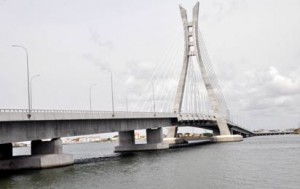The landmark Lekki-Ikoyi Link Bridge in Lagos is the latest of the numerous showpiece overpasses in the bustling city. It has been described as the nation’s first cable-stay bridge.

Its striking 90m high pylon characterises the appearance of the 1,357m long bridge, which connects two districts of Lekki on the Lekki Peninsula and Ikoyi on the Lagos Island. The N29 billion (about $184.6 million) bridge will help relieve the depressing congestion in and around Victoria Island.
The genesis of Lagos’ bridges can be traced to very early in the last century, precisely in 1901, when Carter Bridge was built. It is one of three bridges connecting the Lagos Island to the Lagos Mainland.
At the time of its construction, this was the only bridge connection between the Mainland and the Island. The bridge starts from Iddo on the Mainland and ends at the Idumota area of Lagos Island.
The Carter Bridge was originally constructed by the British colonial government, prior to the Nigerian independence in 1960. After independence, the bridge was dismantled, redesigned and rebuilt during the late 1970s. The Alaka-Ijora Flyover, on the Iddo end of the span, was completed in 1973.
This was followed by the Eko Bridge, which is the shortest of three bridges connecting the Island to the Mainland. It starts from Ijora on the Mainland and ends at the Apongbon area of the Island. The lagoon section of the bridge spans a distance of 430 metres. The bridge and its landward extension of 1,350 metres were constructed in phases between 1965 and 1975. It serves as the preferred access point for vehicular traffic approaching Lagos Island from the Apapa and Surulere areas of Lagos.
In the bid to further ease the increasing stress resulting from commuters’ accessing the Island from the Mainland, the authorities embarked on the ambitious Third Mainland Bridge, which turned out to be not just the longest of the threesome (bridges connecting the Island to the Mainland), but in fact the longest bridge in Africa.

The 11.8km long structure takes off from Oworonshoki which is linked to the Apapa-Oshodi Expressway and Lagos-Ibadan Expressway, and ends at the Adeniji Adele Interchange on Lagos Island. There is also a link midway through the bridge that leads to the Herbert Macaulay Way, Yaba. Built by Julius Berger Nigeria Plc, the bridge was opened by President Ibrahim Babangida in 1990.
However, by 2006, several commuters reported that the six-lane bridge was vibrating noticeably, indicating that it needed urgent attention. As a result, remedial work was done on portions of the bridge, leading to partial closure of the bridge at different times. It now wears a new look from the last repair.
Similarly, the Lagos State Government has commenced preliminary work on the Fourth Mainland Bridge, a 26-kilometre infrastructure designed to link Ikorodu to the state’s economic hub in Eti-Osa Local Government Area.

Estimated to gulp a whopping N160 billion, the bridge will provide access from the hinterland to Victoria Island, which is expected to reduce traffic on the ever-busy Third Mainland Bridge and other bridges linking the Mainland to the Island.

Amid criticisms from the ruling party (Peoples Democratic Party – PDP) bordering on the Lagos government’s perceived insincerity towards the execution of the project, the authorities have maintained that the bridge will be realised.
From illustrations released by government, the bridge (tagged “The People’s Bridge”) will feature two levels – the upper one for vehicular movement and the lower for pedestrian movement that incorporates a daily market facility.
But attention is currently focused on the new cable-stay bridge, which some quarters consider a variant of the suspension bridge.
Though it appears to be the longest, the Lekki-Ikoyi bridge is not the continent’s first suspension bridge. Indeed, South Africa holds the record, with more than six suspension bridges.
One of the oldest bridges was constructed in 1898 and is known as the Levey Bridge. The bridge was constructed in Tsomo, South Africa. The main cables are wire suspension.
The next bridge is the Centurion, which is a crossing bridge at The Centurion Mall. It also uses wired cables for its suspension. It is a very important footbridge in that region. The Johannesburg footbridge in South Africa as well as the footbridge in Pretoria has suspension systems.
The Bloukrans Bridge also known as the Afrikaans Blue Ridges is one of the arch bridges, which were constructed near the tropical rainforest called Nature’s Valley in Western Cape, South Africa.
Completed in 1984, the bridge spans 216m over the Bloukrans River. It is on record as the highest single arch bridge in the world.
The Nelson Mandela Bridge located in Johannesburg, South Africa was constructed in 2003 and the idea was to link Newtown with Braamfontein, both of which are very important business centres in Gauteng. The other objective was to provide an uplifting and modern vista for the city.
